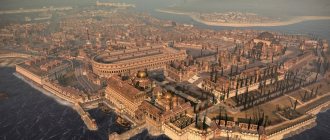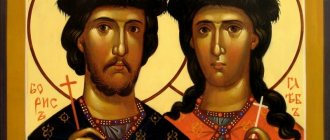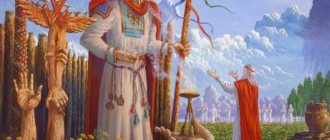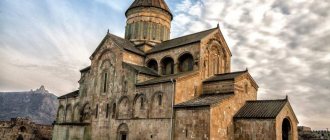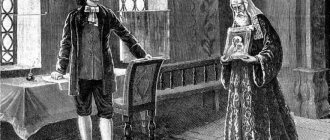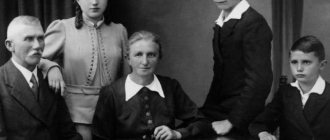There is probably no other more suffering country in the world than Byzantium. Its dizzying rise and such a rapid fall still cause controversy and discussion both in historical circles and among those who are far from history. The bitter fate of the once strongest state of the early Middle Ages leaves neither writers nor filmmakers indifferent - books, films, and TV series are constantly being published, one way or another connected with this state. But the question is: is everything in them true? And how to distinguish truth from fiction? After all, so many centuries have passed, many documents of enormous historical value were lost during wars, conquests, fires, or simply by order of a new ruler. But we will still try to reveal some details of the development of Byzantium in order to understand how such a strong state could meet such a pitiful and inglorious end?
Content
- 1 History of the idea of imperial power
- 2 The sacred and God-protected power of the emperor of Byzantium. Succession to the throne
- 3 Court etiquette. Coronation
- 4 Symphony (“concord”) of the Church and the monarchy
- 5 Emperors of Byzantium 306-1453 (list) 5.1 Emperors of the Byzantine Empire before its conquest by the Crusaders
- 5.2 Emperors of the Nicaean Empire
- 5.3 Emperors of the Latin Crusader Empire
- 5.4 Emperors after the restoration of the Byzantine Empire
- 5.5 Despots of Morea
- 5.6 Links
Capital
This state was a link between East and West. Not everyone knows how many years the Byzantine Empire lasted - 1058 years (period 395-1453).
Map of Byzantium (click to enlarge)
The state occupied a vast territory in Europe, Asia and parts of Africa. Alexandria was first considered the main capital, and then Constantinople.
Why is the Byzantine Empire called the Roman Empire and who are the Romans? Everything is very simple. Initially, the city of Constantinople was called Byzantium, where Emperor Constantine I moved the capital of the empire in 330 and renamed the city “New Rome”.
From here other names came: the inhabitants began to be called “Romeans”, and they called their state Romeysky (meaning Roman).
Now Constantinople is the city of Istanbul (Türkiye).
It is interesting to know which country now occupies the territory of the former Byzantium. Conventionally, it belongs to Turkey, but its land has also been inherited by Greece, the former Yugoslavia, parts of North Africa, as well as small states of Eastern and Central Europe.
History of the idea of imperial power[edit]
St. Justinian (Justinian I the Great)
In Republican Rome, “emperor” was a title that soldiers awarded to a commander for outstanding service. The first rulers of Rome - Gaius Julius Caesar and Octavian Augustus - had it, but their official title was “princeps of the senate” - first in the senate (hence the name of the era of the first emperors - principate). Later the title of Emperor was given to each princeps and replaced it.
Ravenna. 532-547. St. Justinian with his retinue. Mosaic. Ravenna (San Vitale). 532-547
The princeps was not a king. The idea of slavish obedience to a ruler was alien to the Romans of the first centuries of our era (in practice, of course, it happened differently - under such rulers as Caligula, Nero or Commodus). They considered having a king (rex in Latin and vabileus in Greek) to be the destiny of barbarians. Over time, the ideals of the Republic faded into oblivion. Aurelian (270 - 275) finally included the word dominus - master - in his official title. The era of dominance has come, replacing the principate. But it was only in Byzantium that the idea of imperial power took on its most mature form.
Internal organization
All major aspects of the life of the state were decided by the emperor, who was, as many people of that time believed, the viceroy of God. He was actually elected by a majority vote of the representatives of religion and the army in the Senate.
Most often, the crown was inherited, that is, the throne was occupied by dynasties.
Why did the rulers of the Byzantine Empire call themselves successors to the power of the Roman rulers? The fact is that the empire was divided into Western (the capital is Rome) and Eastern (the capital is Constantinople). The first, under the pressure of barbarians, broke up into separate states (modern Malta, Spain, Italy, Algeria, etc.).
The Byzantine emperors considered themselves the heirs of the Great Rome, which no longer existed.
Interesting fact: the state had the so-called Roman rule, which gave the emperor the opportunity to write laws himself.
Despite this, legal commissions existed in Byzantium. Administrative and territorial management was also adopted from the Romans.
Constant wars required the state to have a good army and a powerful navy. Representatives of these categories had good living conditions, and were a priority for the emperor.
Diplomacy was often in a neutral form. Paintings were presented as gifts to envoys of other states. To consolidate an alliance with other countries, marriage between representatives of these states was used.
The sacred and God-protected power of the Emperor of Byzantium. Succession[edit]
Just as God is the highest of the whole world, so the emperor heads the earthly kingdom. The power of the emperor, who stood at the top of the earthly empire, organized in the likeness of the “heavenly” hierarchy, is sacred and protected by God.
But the king (the title of Basileus of the Romans was officially adopted in 629 by Heraclius I, although the people began to call their rulers that way much earlier), who did not observe “divine and human laws,” was considered a tyrant, and this could serve as a justification for attempts to overthrow him.
In moments of crisis, such changes in power became common, and any citizen of the state could become an emperor (the principle of hereditary power took shape only in Byzantium in recent centuries), therefore both a worthy and an unworthy person could be on the throne. On the latter occasion, Niketas Choniates, a historian who survived the defeat of his homeland by the crusaders, sadly complained: “There were people who yesterday or, in a word, recently gnawed acorns and still chewed Pontic pork in their mouths [dolphin meat, the food of the poor], and now they completely openly expressed their views and claims to royal dignity, fixing their shameless eyes on him, and used them as matchmakers, or better [to say] pimps, corrupt and servile public screamers... O famous Roman power, the subject of envious surprise and reverent veneration of all peoples, - who has not taken possession of you by force? Who hasn't dishonored you brazenly? What wildly violent lovers have you not had? Whom did you not embrace in your arms, with whom did you not share a bed, to whom did you not give yourself, and then whom did you not cover with a crown, adorn with a diadem and then put on red sandals?”
Feature films about Byzantium
Film The Byzantine Princess (2006)
Feature films about the Great Byzantine Empire will help you expand your knowledge and visually see the life of the Byzantines:
- cartoon "Prince Vladimir" (2006),
- fairy tale film “Vasily Buslaev” (1982),
- “Primordial Rus'” (1985) two-part historical adventure historical film,
- “Khan Asparukh” (1981) - a three-part Bulgarian film,
- "A Knight's Romance" (2000),
- "Byzantine Princess" (2006),
- Conquest 1453 (2012) is a Turkish epic film about the conquest of Constantinople.
Court etiquette. Coronation[edit]
Regardless of who occupied the throne, the etiquette of the Byzantine court was unparalleled in solemnity and complexity. The residence of the emperor and his family was, as a rule, the Great Imperial Palace - a complex of buildings in the center of Constantinople. During the time of the last Komnenos, the Great Palace fell into disrepair, and the basileos moved to the [Blachernae Palace|Blachernae Palace].
Any exit of the sovereign was strictly regulated by the rules. Each ceremony involving the emperor was planned down to the smallest detail. And of course, the accession to the throne of the new king was celebrated with great solemnity.
The rite of proclamation itself has not remained unchanged over the centuries. In early Byzantium, the coronation was of a secular nature; the Roman emperor was officially elected by the synclite, but the army played a decisive role. The coronation ceremony took place surrounded by selected units; the candidate for emperor was raised on a large shield and shown to the soldiers. At the same time, the neck chain of an officer-campiductor (torques) was placed on the head of the proclaimed one. There were shouts: “So-and-so, you win (tu vincas)!” The new emperor distributed donativ - a monetary gift - to the soldiers.
From 457, the Patriarch of Constantinople began to take part in the coronation (see “Leo I”). Later, the church's participation in the coronation became more active. The ceremony of raising on a shield faded into the background (perhaps it disappeared altogether from the 8th century). The ritual of proclamation became more complex and began to begin in the chambers of the Grand Palace. After several changes of clothes and greetings from the courtiers and members of the synclite, the candidate entered the mitatorium - an annex to the church of St. Sofia, where he dressed in ceremonial clothes: divitisy (a type of tunic) and tsitsaky (a type of cloak - chlamys). Then he entered the temple, walked to the solea, prayed and entered the pulpit. The Patriarch read a prayer over a purple robe and put it on the emperor. Then the crown was taken out of the altar, and the patriarch placed it on the head of the new basileus. After this, the praises of the “dims”—representatives of the people—began. The emperor left the pulpit, returned to the mitatorium and received the worship of the members of the synclite there.
Since the 12th century, the custom of raising a candidate to the shield was revived again, and anointing was added to the rite of placing on the throne. But the meaning of the first rite has changed. The candidate was no longer raised on a shield by soldiers, but by the patriarch and the highest secular dignitaries. Then the emperor went to St. Sofia and participated in the service. After the prayer, the patriarch anointed the head of the basileus with myrrh in a cross shape and proclaimed: “Holy!”; This exclamation was repeated three times by the priests and representatives of the people. Then the deacon brought in the crown, the patriarch put it on the emperor, and cries of “Worthy!” were heard. A master approached the reigning emperor with samples of marble and asked him to choose the material for the coffin - as a reminder that the ruler of the God-protected Roman Empire was also mortal.
The ceremonial entrance of the emperor (possibly Justinian II). Fresco of the Church of St. Demetrius in Thessaloniki
The proclamation of the “junior” emperor-co-ruler (boomvabileus) was framed somewhat differently. Then the senior emperor laid the crown and mantle - accepting them, however, from the hands of the patriarch.
Culture
Culture also depended on the nationalities of specific provinces. It is known that different peoples lived on the territory of Byzantium: Armenians, Jews, Judeans, Syrians, Thracians and Illyrians.
The following features can be distinguished in the development of Byzantine culture:
- The spiritual sphere played a special role in the social sphere of life of the population.
- It was here that all the early treatises, reference books, and knowledge were collected and systematized.
- Individualism manifested itself in all spheres of art.
- A special cult of the emperor and the unification of science and art developed.
Church of Panagia Byzantium
It is important that there was no division of scientific branches. This could be seen in architecture, painting, literature and music - everywhere you can see a mixture of styles.
Symphony (“concord”) of the Church and the monarchy[edit]
The important role of the church in the coronation ritual was not accidental, but was dictated by the special relations between the secular and spiritual authorities of the Roman Empire.
Even in the days of pagan Rome, the emperor had the title of high priest - pontifex maximus. This tradition was preserved in Orthodox Byzantium. Basileus were revered as defensors or ekdiki (defenders, trustees) of the church, bore the title afios - “saint”, could participate in the service, and, along with the clergy, had the right to enter the altar. They decided questions of faith at councils; By the will of the emperor, the Patriarch of Constantinople was elected from the candidates proposed by the bishops (usually three).
Emperor John VI Cantacuzene presides over the church council. Paris. National Library. GR. 1242. 14th century
In terms of the political ideal of relations between the Roman king and the Orthodox Church, which mainly developed by the middle of the 6th century. and lasted until the fall of the empire, there was a symphony - “concord”. The symphony was a recognition of the equality and cooperation of secular and spiritual authorities. “If a bishop obeys the orders of the emperor, then not as a bishop, whose power, as a bishop, would derive from the imperial power, but as a subject, as a member of the state, obliged to show obedience to the sovereign power placed over him by God; in the same way, when the emperor submits to the determinations of the priests, it is not because he bears the title of priest and his imperial power stems from their power, but because they are priests of God, ministers of the faith revealed by God, therefore - as a member of the church, seeking, like other people, their salvation in the spiritual kingdom of God.” In the preface to one of his short stories, Emperor Justinian I wrote: “The Most High goodness imparted to humanity two greatest gifts - the priesthood and the kingdom; then [the first] is concerned with pleasing God, and this [the second] is concerned with other human objects. Both, emanating from the same source, constitute the adornment of human life. Therefore, there is no more important concern for sovereigns than the well-being of the priesthood, which, for its part, serves them as a prayer to God for them. When the church is well-organized on all sides, and government moves firmly and through laws directs the life of peoples towards the true good, then a good and beneficial union of church and state arises, so desired for humanity.”
Byzantium did not know such a fierce struggle between sovereigns and the church for power that reigned in the Catholic West throughout almost the entire Middle Ages. However, if the emperor violated the requirements of the symphony and thereby gave reason to accuse himself of non-Orthodoxy, this could serve as an ideological banner for his opponents, “for the kingdom and the church are in the closest union, and ... it is impossible to separate them from each other. Only those kings are rejected by Christians who were heretics, raged against the church and introduced corrupting dogmas alien to the apostolic and paternal teachings” (Patriarch Anthony IV).
The proclamation of the symphony as an official doctrine did not at all mean the inevitable implementation of this ideal in practice. There were emperors who completely subjugated the church (Justinian the Great, Basil II), and there were patriarchs who considered themselves entitled to lead emperors (Nicholas the Mystic, Michael Kirularius).
Over time, the glory of the empire faded, but the authority of its church among the Orthodox remained unquestioned, and the emperors of Byzantium, albeit nominally, were considered their overlords. At the end of the 14th century. Patriarch Anthony IV wrote to the Grand Duke of Moscow Vasily Dmitrievich: “Although, by God’s permission, the infidels constrained the power of the tsar and the borders of the empire, yet to this day the tsar is appointed by the church according to the same rank and with the same prayers [as before], and to this day he is anointed with the great chrism and appointed king and autocrat of all the Romans, that is, Christians.”
Constantinople
The new capital had an excellent natural harbor at the entrance to the Golden Horn and, commanding the border between Europe and Asia, could control the passage of ships through the Bosporus from the Aegean to the Black Sea, linking the lucrative trade between West and East. It should be noted that the new state actively took advantage of this advantage. And, oddly enough, the city was well fortified. A great chain stretched across the entrance to the Golden Horn, and the construction of the massive walls of Emperor Theodosius (between 410 and 413) meant that the city was able to withstand attacks from both sea and land. Over the centuries, more impressive buildings were added , the cosmopolitan city has become one of the best of any era and by far the richest, most generous and most important Christian city in the world. In general, Byzantium occupied vast territories on the world map - the countries of the Balkan Peninsula, the Aegean and Black Sea coasts of Turkey, Bulgaria, Romania - all of them were once part of Byzantium.
It is necessary to note another, important detail - Christianity became the official religion in the new city. That is, those who were mercilessly persecuted and brutally executed in the Roman Empire found shelter and peace in the new country. Unfortunately, Emperor Constantine did not see the heyday of his brainchild - he died in 337. The new rulers paid increasing attention to the new city on the outskirts of the empire. In 379, Theodosius gained power over the eastern provinces. First as a co-ruler, and in 394 he began to rule independently. He is considered the last Roman emperor, which is generally true - in 395, when he died, the Roman Empire split into two parts - Western and Eastern. That is, Byzantium received the official status of the capital of the new empire, which also became known as Byzantium. This year marks the beginning of a new country on the map of the ancient world and the emerging Middle Ages.
Emperors of the Byzantine Empire before its conquest by the Crusaders[edit]
Constantine I the Great (306-337) Licinius (308-324) Constantius I (337-350) Constantius II (337-361) Julian II the Apostate (361-363) Jovian (363-364) Procopius (usurper, ruled ca. 365 ) Valens II (364-378) Theodosius I the Great (379-395) Arcadius (395-408) Theodosius II the Younger (408-450) Marcian (450-457) Leo I Maccellus the Thracian (457-474) Leo II (474) Zeno (474-491,475-476 - outside Constantinople) Basilisk (475-476) Anastasius I Dicorus (491-518) Justin I (518-527) Justinian I the Great (527-565) Theodora I (527-548) Justin II ( 565-578) Tiberius II (574-582) Mauritius (582-602) Phocas (602-610) Heraclius I (610-641) Constantine III (641) Herakleion (Heraclius II) (641) Constans II (641-668)
Trebizond Emperor Alexius III the Great Komnenos and Empress Theodora. An 18th century copy of a manuscript from 1374. Athos, Dionisio Monastery
Constantine IV Pogonatus (668-685) Justinian II Rhinotmet (685-695 and 705-711) Leontius (695-698) Tiberius III (Apsimar) (698-705) Fnlippic (Vardan) (711-713) Anastasius II (Artemius) (713-716) Theodosius III (715-717) Leo III Isaurian or Syrian (717-741) Constantine V Copronymus or Cavallinus (741-775, 742-743 - outside KPlya) Artavasdes (742-743) Leo IV Khazar (775 -780) Irina (780-790 and 797-802) Constantine VI Porphyrogenitus (790-797) Nikephoros I Genik (802-811) Stavraki (811) Michael I Rangave (811-813) Leo V the Armenian (813-820) Michael II Travl (820-829) Theophilus (829-842) Theodora (II) (842-856) Michael III Drunkard (856-867) Basil I the Macedonian (867-886) Leo VI Philosopher (886-912) Alexander (912- 913) Zoe I Karvonopsina (914-919) Roman I Lekapin (919-944 Dec. 16) Constantine VII Porphyrogenet (independent from Jan. 27, 945 - +959 Nov.) Roman II (959- +963 March 15) Theophano (963 ) Nikephoros II Phocas (963-969) John I Tzimisces (969-976) Basil II Bulgarokton (976-1025) Constantine VIII (1025 -1028) Romanos III Argyrus (1028 -1034) Michael IV Paphlagon (1034-1041) Michael V Calafates (1041 -1042) Zoe II Porphyrogenita (1042) Constantine IX Monomachus (1042-1055) Theodora (III) Porphyrogenita (1042 and 1055 -1056) Michael VI Stratioticus (1056-1057) Isaac I Komnenos (1057 -1059) Constantine X Dukas (1059 -1067) Eudokia Makremvolitis (1067 and 1071)
File:Manuel2.jpg Emperor Manuel II Palaiologos
Roman IV Diogenes (1068 -1071) Michael VII Ducas Parapinac (1071 -1078) Niknphoros III Botaniates (1078-1081) Alexius I Komnenos (1081 -1118) John II Komnenos (1118 -1143) Manuel I Komnenos (1143 -1180) Alexey II Komnenos (1180-1183) Andronikos I Komnenos (1183 -1185) Isaac II Angel (1185 -1195 and 1203-1204) Alexios III Angel (1195 -1203) Alexios IV Angel (1203 -1204) Alexios V Ducas Murfuzl (1204) Constantine XI Laskaris (1204-1205)
Emperor Charioteer
Emperors after the restoration of the Byzantine Empire[edit]
Michael VIII Palaiologos (1261-1282) Andronikos II Palaiologos the Elder (1282 -1328) Michael IX Palaiologos (1295-1320) Andronikos III Palaiologos the Younger (1325-1341) John V Palaiologos (1341 -1391, with breaks in 1376 -1379 and 1390 ) John VI Cantacuzene (1341-1354) Matthew Cantacuzene (1353 -1357, from 1354 - outside the CP) Andronikos IV Palaiologos (1376-1379) John VII Palaiologos (1390, regent in 1399 -1403) Manuel II Palaiologos (1391-1425) John VIII Palaiologos (1425-1448) Constantine XII Palaiologos Dragash (1448-29 May 1453)
The main achievements of the Roman Empire
However, the culture of this state has brought a certain contribution to other countries: culture, legislation, languages, traditions and customs, faith.
The main achievements of the Byzantine Empire:
- the emergence of a hierarchical system of government,
- trade development,
- big role of cities
- use of religion for state purposes,
- development of architecture,
- high role of the state in economic development,
- preservation and development of knowledge in the field of ancient mathematics, medicine, geography, chemistry.
